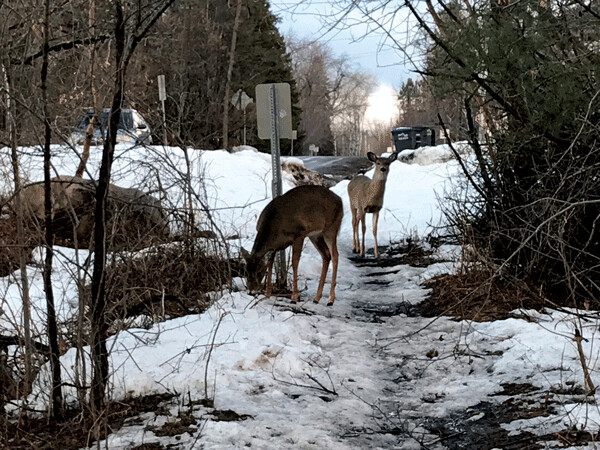There’s a deer in my yard
Urban deer concentration seems high

Unlike their skittish country cousins, urban deer roaming Duluth’s east end seem to have grown almost fearless of humans.
Walking up a trail from Lake Superior to London Road on a recent evening just before dusk, I was easily within spitting distance of a pair of deer nibbling at twigs and grasses poking up along the trail after two consecutive days of sun. One of them looked up at me and then quickly returned to eating while the other one continued to watch me before she, too, began nibbling at the ground again.
Only when I took a couple of steps closer did they finally wander off into a residential yard next to the trail, and as soon as I stepped from the trail onto the pavement of 42nd Avenue, they returned to the trail and bowed their heads again to eat.
“Not sure why they’re all congregating down there. It just must be good cover and they’re able to get around,” said Martha Minchak, assistant area wildlife manager for the Minnesota Department of Natural Resources, who said she has been fielding an unusually high number of calls this winter about the urban deer that have been roaming the area.
“I’ve had more calls this winter than most winters,” she said, adding that people have called in to report everything from a couple of deer in their yard to what looked like a herd moving through alleys.
“I don’t think I’ve heard of these kinds of concentrations in town before,” Minchak said. “I think they’ve just kind of given up just in order to survive. They’ve come really close to people.”
Many of those who call the DNR have questions about feeding the deer.
“We don’t recommend that,” Minchak said. “We don’t recommend feeding at all because it unnaturally concentrates them in these big groups. They’ve evolved just fine on their own.”
She said there are several other reasons not to feed the deer, not the least of which being that it is illegal to do so in areas where controlled hunts are held, and Duluth has been open to bowhunting of urban deer since 2005 when the city council approved hunting to decrease the surplus population of deer grazing in neighborhoods.
The other reason is that some people are inadvertently killing the deer with kindness. Minchak said she’s heard from people who have walked up to deer that were just sitting there, looking like they’re alive.
“But they’ve died,” she said. “A lot of that is due to feeding them corn. Their systems switched over last fall to browse and woody vegetation so they can’t handle the high carbohydrate loads of corn. They can literally die with full stomachs and mouths. We’ve had cases of that in the city and around the area with folks feeding deer. So, if you care about them, you should not feed them because you can kill them while you’re trying to look after them.”
Soon, Minchak said, the winter weather should break and the urban deer will hopefully slip back into the countryside.
